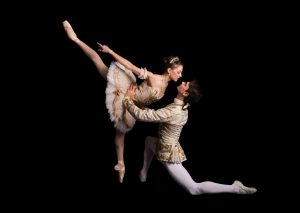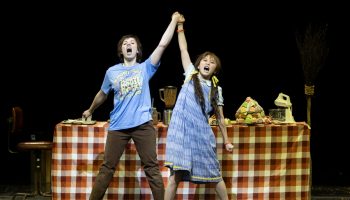Story by Val Lick and Maggie Prosser-
Preparing for Pittsburgh Ballet Theatre’s Chautauqua performance was a considerable feat, as it involved coordinating artistic powerhouses in two cities. But the result, said PBT Artistic Director Terrence Orr, emanates the PBT’s, School of Dance’s and Chautauqua Symphony Orchestra’s shared “love for dance.”
Returning to Chautauqua Institution for the first time since its debut in 2017, PBT will present two beloved ballets — George Balanchine’s “Rubies,” and an abridged Sleeping Beauty — at 8:15 p.m. Saturday, July 13 in the Amphitheater.
“This is a Sleeping Beauty … of a different sort,” said Orr, who announced he will retire in June 2020. “I’m not really telling the story; I’m just going through and doing the divertissement, the different dances that go on.”
Orr’s Sleeping Beauty, accompanied by the CSO, will open with the christening of Princess Aurora and six fairy variations. Act I will include, in Orr’s words, the ballet’s “key scene” — the Rose Adagio, a pas de deux between Aurora and four suitors.
Act II will feature 24 students from the School of Dance in the garland dance, and Act III, the wedding, will feature six couples from the School of Dance, the usual line of characters — Bluebird, Puss and Boots, the White Cat — and PBT’s traditional ending to the ballet, Orr said.
In total, Aurora will be played by three PBT dancers and Aurora’s love interest, Prince Desire, will be played by two dancers.
The CSO’s rendition of Pyotr Ilyich Tchaikovsky’s musical score, under the direction of CSO Music Director and Conductor Rossen Milanov, will be the second of three performances in its inaugural “Russian Festival.”
“Tchaikovsky’s Sleeping Beauty is one of the three big ballets, alongside Swan Lake and The Nutcracker, that really made him one of the most important composers in the ballet world,” Milanov said.
Milanov said Sleeping Beauty focuses on the visual and auditory aspects of the performance, rather than dramatic elements.
“Sleeping Beauty is a little more decorative in nature; it’s more about the ballet itself than having some big, dramatic, controversial, romantic story like Swan Lake,” Milanov said. “This one is mostly for the eyes, and of course the ears; Tchaikovsky was one of the most colorful orchestrators and masters of the short formats. … He had the gift to find the perfect music to match the dance variations that occur throughout the ballet.”
Prefacing Sleeping Beauty will be “Rubies,” set to Igor Stravinsky’s “Capriccio for Piano and Orchestra.” “Rubies” — the electric second movement of George Balanchine’s three-act Jewels — will feature renowned pianist William Wolfram.
“This particular piece belongs to the period (of Stravinsky’s work) in which we could hear very strong influences of Russian folk music,” Milanov said. “It’s not as abstract as some of his later works, but it has this incredible ingenuity — the way he works with musical material and combines them together. There is always a fascination of how these collages of sound could function together.”
This will be PBT’s second performance with the CSO, its second performance on the Amp stage, and its first collaboration with the School of Dance. Prior to the performance, the Chautauqua Dance Circle will host a dance preview with PBT at 7 p.m. Saturday, July 13 in Smith Wilkes Hall.
“This is going to be great fun,” Orr said. “It’s an honor to be part of such an incredible institution.”





